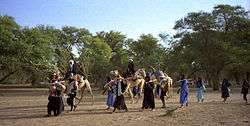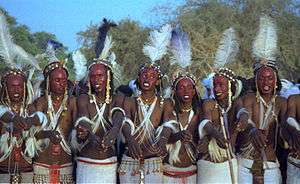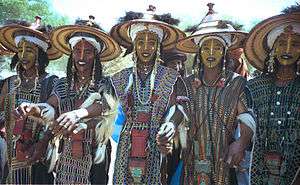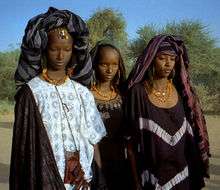Wodaabe
The Wodaabe (Fula: Woɗaaɓe), also known as the Mbororo or Bororo, are a small subgroup of the Fulani ethnic group. They are traditionally nomadic cattle-herders and traders in the Sahel, with migrations stretching from southern Niger, through northern Nigeria, northeastern Cameroon, southwestern Chad, western region of the Central African Republic and the northeastern of the Democratic Republic of Congo .[1] The number of Wodaabe was estimated in 2001 to be 100,000.[2][3] They are known for their elaborate attire and rich cultural ceremonies.
 A group of traveling Wodaabe. Niger, 1997 | |
| Total population | |
|---|---|
| 100,000 (2001) | |
| Regions with significant populations | |
| Languages | |
| Fula | |
| Religion | |
| Islam, African traditional religion | |
| Related ethnic groups | |
| Fula |
The Wodaabe speak the Fula language and don't use a written language.[4] In the Fula language, woɗa means "taboo", and Woɗaaɓe means "people of the taboo". This is sometimes translated as "those who respect taboos", a reference to the Wodaabe isolation from broader Fulbe culture, and their contention that they retain "older" traditions than their Fulbe neighbors.[5] In contrast, other Fulbe as well as other ethnic groups sometimes refer to the Wodaabe as "Mbororo", a sometimes pejorative name,[6] translated into English as "Cattle Fulani", and meaning "those who dwell in cattle camps".[7] By the 17th century, the Fula people across West Africa were among the first ethnic groups to embrace Islam, were often leaders of those forces which spread Islam, and have been traditionally proud of the urban, literate, and pious life with which this has been related. Both Wodaabe and other Fulbe see in the Wodaabe the echoes of an earlier pastoralist way of life, of which the Wodaabe are proud and of which urban Fulbe are sometimes critical.[6][8]
The Wodaabe culture is one of the 186 cultures of the standard cross-cultural sample used by anthropologists to compare cultural traits.
A Wodaabe woman, Hindou Oumarou Ibrahim, was chosen to represent civil society of the world on the signing of Paris Protocol on 22 April 2016.[9]
Everyday life
The Wodaabe keep herds of long-horned Zebu cattle. The dry season extends from October to May. Their annual travel during the wet season follows the rain from the south to the north.[10] Groups of several dozen relatives, typically several brothers with their wives, children and elders, travel on foot, donkey or camel, and stay at each grazing spot for a couple of days. A large wooden bed is the most important possession of each family; when camping it is surrounded by some screens. The women also carry calabashes as a status symbol.[4] These calabashes are passed down through the generations, and often provoke rivalry between women. The Wodaabe mostly live on milk and ground millet, as well as yogurt, sweet tea and occasionally the meat of a goat or sheep.
Religion, morals and customs
Wodaabe religion is largely Islamic (mixed with pre-Islamic beliefs).[11] Although there are varying degrees of orthodoxy exhibited, most adhere to at least some of the basic requirements of the religion.[12] Islam became a religion of importance among Wodaabe peoples during the 16th century when the scholar al-Maghili preached the teachings of Muhammad to the elite of northern Nigeria. Al-Maghili was responsible for converting the ruling classes among Hausa, Fulani, and Tuareg peoples in the region.[1]
The code of behavior of the Wodaabe emphasizes reserve and modesty (semteende), patience and fortitude (munyal), care and forethought (hakkilo), and loyalty (amana). They also place great emphasis on beauty and charm.[13]
Parents are not allowed to talk directly to their two first born children, who will often be cared for by their grandparents. During daylight, husband and wife cannot hold hands or speak in a personal manner with each other.[4]


Beauty ideal and Gerewol festival
At the end of the rainy season in September, Wodaabe clans gather in several traditional locations before the beginning of their dry season transhumance migration. The best known of these is In-Gall's Cure Salée salt market and Tuareg seasonal festival. Here the young Wodaabe men, with elaborate make-up, feathers and other adornments, perform the Yaake: dances and songs to impress marriageable women. The male beauty ideal of the Wodaabe stresses tallness, white eyes and teeth; the men will often roll their eyes and show their teeth to emphasize these characteristics. Wodaabe clans then join for the remainder of the week-long Gerewol: a series of barters over marriage and contests where the young men's beauty and skills are judged by young women.[14]
Documentaries and popular culture
The 1989 documentary Wodaabe - Herdsmen of the Sun by Werner Herzog describes the Wodaabe.
In the 1999 documentary Zwischen 2 Welten (between two worlds) director Bettina Haasen films her personal conversations with Wodaabe members.
The 2010 ethnographic documentary Dance with the Wodaabes by Sandrine Loncke explores, from the point of view of its participants, the complex cultural significance of the spectacular but frequently misunderstood and sensationalized Wodaabe ritual celebrations known as "Geerewol".
The Niger-based band Etran Finatawa is composed of Wodaabe and Tuareg members and creates their unique style of "Nomad Blues" by combining modern arrangements and electric guitars with more traditional instruments and polyphonic Wodaabe singing. In 2005 they recorded an album and toured Europe.
"Wodaabe Dancer" is the name of an instrumental track on guitarist Jennifer Batten's 1997 album, Jennifer Batten's Tribal Rage: Momentum.
 Young Wodaabe women with facial tattoos
Young Wodaabe women with facial tattoos Two Wodaabe men
Two Wodaabe men A young woman judging the beauty of men at a Gerewol
A young woman judging the beauty of men at a Gerewol North Beauty from Cameroon
North Beauty from Cameroon
References
- "Wodaabe People". University of Iowa.
- http://fernwhitehilsenrath.wordpress.com/tag/the-wodaabe-tribe/
- Phillips, David J. (2001). Peoples on the Move: Introducing the Nomads of the World. ISBN 9780878083527.
- Carol Beckwith, Niger's Wodaabe: "People of the Taboo". National Geographic, 1983, vol. 164, no4, pp. 483–509
- Loftsdóttir, Kristín. When nomads lose cattle: Wodaabe negotiations of ethnicity. African Sociological Review 2004, 8(2): 52–76
- Carol Beckwith. An Interview with Carol Beckwith. African Arts, Vol. 18, No. 4 (Aug. 1985), pp. 38–45
- EA BRACKENBURY. NOTES ON THE "BORORO FULBE" OR NOMAD "CATTLE FULANI" African Affairs, vol. XXIII, number 208, 1924
- Mette Bovin (2001), p.13
- Indigenous Mbororo woman to speak at Paris Agreement signing ceremony on 22 April. Sustainable Development Goals, United Nations. Retrieved on 15 June 2016.
- Gabrielle Lyon, The Wodaabe
- Skutsch, Carl, ed. (2005). Encyclopedia of the World's Minorities. New York: Routledge. p. 229. ISBN 1-57958-468-3.
- "Wodaabe religion". Africa.com.
- Beckwith, Carol, and Angela Fisher. African Ceremonies. New York: Harry N Abrams, 1999.
- Niger's dandy Gerewol festival, The Times, 4 July 2004
Sources
- Beckwith, Carol. Nomads of Niger. Harry N. Abrams, Inc. 1993.
- Beckwith, Carol. Niger's Wodaabe: People of the Taboo, National Geographic, October 1983
- Bovin, Mette. Nomads who cultivate beauty: Wod̳aab̳e dances and visual arts in Niger. Nordic Africa Institute, 2001 ISBN 978-91-7106-467-7
- Loncke, Sandrine. Geerewol : Musique, danse et lien social chez les Peuls nomades wodaabe du Niger. Société d'ethnologie, 2015, 415 p. (with a DVD-ROM including annotated music recordings, short videos and the documentary feature La danse des Wodaabe) ISBN 9782365190091
- Loncke, Sandrine. Mémoire et transmission musicale dans une société nomade. L’exemple des Peuls Wodaabe du Niger, Cahiers d'ethnomusicologie 22, 2008, p. 203-222
External links
| Wikimedia Commons has media related to Wodaabe. |
- Website of Djingo, the Wodaabe collectif in Niger
- Article on the creation of the Wodaabe collectif
- Report on a 2001 trip with a Wodaabe group to Cure Salée, from Sahara with Michael Palin
- Radio program on Fulbe Wodaabe and Fulbe Jelgoobe singing and dancing : À corps et à voix avec les Peuls Jelgoobe et Wodaabe, by Sandrine Loncke, France Musique, April 2015.
- Online musical archives dedicated to Fulbe Wodaabe singings (Telemeta, CREM-CNRS).
Photos and videos
- Gerewol photos by BBC Human Planet photographer
- Video of Wodaabe dance
- Video of Gerewol festival, National Geographic
- Wodaabe dancer photos: part 1, part 2
- Mr Sahara 2004
- The Wodaabe's Cure Salée by Christine Nesbitt
- Festival of the Nomads – Cure Salée
- Conversation with Woodabe member about marriage (Experience from Cure Salée festival and Wodaabé photos)
- Geerewol, by Sandrine Loncke (Website about Wodaabe ritual celebrations, with annotated music recordings and short videos featuring dance and ritual sequences. Supplement to the book of the same author).
- Dance with the Wodaabes, documentary feature directed and produced by Sandrine Loncke, Berkeley Media, 90', 2010
- Wodaabe, Dance instead of War , documentary feature written and directed by Sandrine Loncke, Point du Jour International, 52', 2013